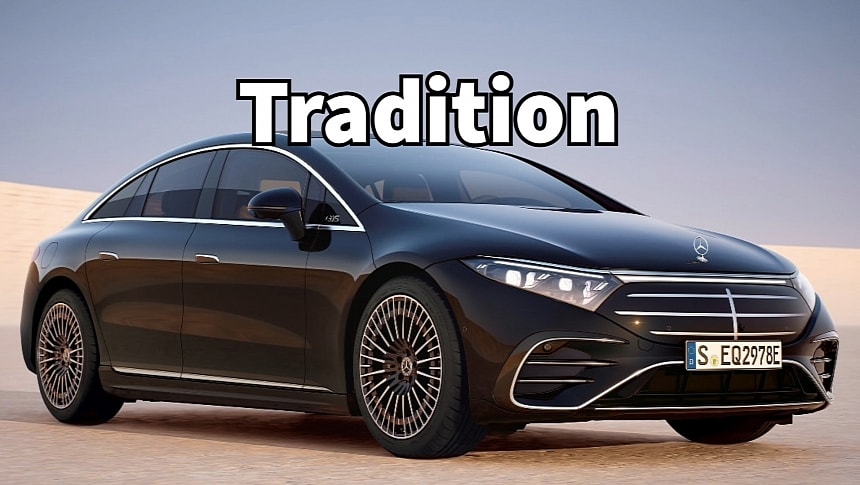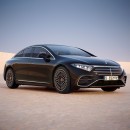Mercedes-Benz is blurring the lines between its electric vehicles and their gas-powered variants. This will also affect the design, which should be unified across the brand's lineup, regardless of the propulsion system. Robert Lesnik, head of exterior design at Mercedes-Benz, confessed that he sees all EVs poised to look the same at some point, and wants to avoid that with Mercedes-Benz's models.
Years ago, people noticed that hybrid cars had a bizarre, pill shape that was adopted by several carmakers. It was easy to see a resemblance between the Toyota Prius, Honda Insight, and Hyundai Ioniq. The reason why carmakers agreed to design their hybrid vehicles in a similar fashion was aerodynamics. For the first time, carmakers optimized the design for the best aerodynamic efficiency possible. Toyota did it, and others copied it, although aerodynamics advancements in recent years have shown that you can achieve better efficiency with different designs.
This was one of the reasons electric vehicles were not among the most exciting in terms of design. To make matters worse, traditional carmakers wanted to give their electric vehicles a distinctive design that would make them stand out in their lineup. Not only that, but some of them even created specialized lineups or sub-brands for their EVs. Mercedes-Benz was one of them, although other German carmakers followed a similar recipe.
In 2013, BMW launched its first modern electric car, the i3, and expanded the lineup with a whole range of i-branded EVs. Volkswagen followed suit in 2019 with its ID. electric lineup and Mercedes-Benz launched the EQ brand with the EQC the same year. It wasn't just branding because all German carmakers opted to give their electric vehicles distinctive designs, even when they were clearly derivative of ICE models. Despite sharing most of the components, the Mercedes-Benz EQC didn't look like the GLC.
This trend is now coming to an end, as electric vehicles entered the mainstream, and carmakers want them to be perceived as the new normal. After Volkswagen hinted at ditching the ID. branding, Mercedes-Benz announced a similar move, with its future electric vehicles wearing the same names as their ICE variants. More than this, the German carmaker wants them to look the same, ditching all the efforts it made during the early days of electric vehicles.
The move has been talked about by Mercedes-Benz's head of exterior design, Robert Lesnik, in an interview with Autocar. The new design direction has already been teased with the release of the refreshed EQS, which adopted a traditional grille design. And if you look at the recently launched G 580 EQ, it looks almost the same as the ICE G-Class models. Lesnik told Autocar that there's no real need to make EVs look different because customers are already used to electric vehicles.
Of course, this means that Mercedes-Benz will have to offer the same aerodynamic optimizations to its ICE vehicles. Otherwise, there IS a need to make EVs look different, and that is dictated by efficiency. You can't expect to have competitive electric cars without squeezing every mile out of them by eliminating losses at every step, from power electronics and drive units to drivetrain and aerodynamics. Thankfully, this is something Lesnik agrees with.
"To make something electric just doesn't make sense if you don’t offer a certain amount of range to a customer," admitted Lesnik during the interview. "If you would have a car with [only] 100 km of range, it would not make sense." However, this didn't matter with the electric G-Class, one of Mercedes-Benz's most iconic models. Instead, the design philosophy was that "from 20 meters, you should not spot the difference with the ICE car." If this will prove successful, it remains to be seen.
This was one of the reasons electric vehicles were not among the most exciting in terms of design. To make matters worse, traditional carmakers wanted to give their electric vehicles a distinctive design that would make them stand out in their lineup. Not only that, but some of them even created specialized lineups or sub-brands for their EVs. Mercedes-Benz was one of them, although other German carmakers followed a similar recipe.
In 2013, BMW launched its first modern electric car, the i3, and expanded the lineup with a whole range of i-branded EVs. Volkswagen followed suit in 2019 with its ID. electric lineup and Mercedes-Benz launched the EQ brand with the EQC the same year. It wasn't just branding because all German carmakers opted to give their electric vehicles distinctive designs, even when they were clearly derivative of ICE models. Despite sharing most of the components, the Mercedes-Benz EQC didn't look like the GLC.
This trend is now coming to an end, as electric vehicles entered the mainstream, and carmakers want them to be perceived as the new normal. After Volkswagen hinted at ditching the ID. branding, Mercedes-Benz announced a similar move, with its future electric vehicles wearing the same names as their ICE variants. More than this, the German carmaker wants them to look the same, ditching all the efforts it made during the early days of electric vehicles.
The move has been talked about by Mercedes-Benz's head of exterior design, Robert Lesnik, in an interview with Autocar. The new design direction has already been teased with the release of the refreshed EQS, which adopted a traditional grille design. And if you look at the recently launched G 580 EQ, it looks almost the same as the ICE G-Class models. Lesnik told Autocar that there's no real need to make EVs look different because customers are already used to electric vehicles.
Of course, this means that Mercedes-Benz will have to offer the same aerodynamic optimizations to its ICE vehicles. Otherwise, there IS a need to make EVs look different, and that is dictated by efficiency. You can't expect to have competitive electric cars without squeezing every mile out of them by eliminating losses at every step, from power electronics and drive units to drivetrain and aerodynamics. Thankfully, this is something Lesnik agrees with.
"To make something electric just doesn't make sense if you don’t offer a certain amount of range to a customer," admitted Lesnik during the interview. "If you would have a car with [only] 100 km of range, it would not make sense." However, this didn't matter with the electric G-Class, one of Mercedes-Benz's most iconic models. Instead, the design philosophy was that "from 20 meters, you should not spot the difference with the ICE car." If this will prove successful, it remains to be seen.








